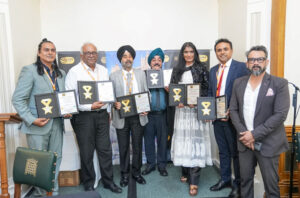Bengaluru scientists develop off-grid mobile oxygen concentrator

Figure: The inside view of the device, which consists of three parts.
New Delhi: A team of researchers at Bengaluru-based Jawaharlal Nehru Centre for Advanced Scientific Research (JNCASR), an autonomous institute under the Department of Science & Technology, Government of India, has designed a robust, mobile oxygen concentrator that can be used in rural settings and be rapidly deployed in emergencies in any location.
The second wave of COVID-19 had witnessed an acute shortage of medical oxygen in different parts of the country. While the crisis in the bigger cities was more about responding by overcoming supply chain limitations, in smaller cities and villages, the crisis exposed a chronic lack of medical oxygen infrastructure.
Overcoming the crisis required combining the advantages of personalized Oxygen concentrators for home uses with a capacity of 5 to 10 litres per minute (lpm) and Oxygen plants with a capacity of 500 lpm for large hospitals. The 500 lpm plants for hospitals are robust. But, they lacked the portability required for deployment in resource-poor settings. The personal concentrators, on the other hand, were portable but too fragile to be used on a sustained basis in hospital settings. There was a need for a robust technology with necessary portability.
The team at JNCASR has come up with a solution that meets the requirement, addressing, among other things, the several novel design challenges posed for the sourcing of materials. The device is based on the principles of Pressure Swing Adsorption (PSA) technology. The team replaced lithium zeolites (LiX) which is usually used in oxygen concentrators, with sodium zeolites which does not generate toxic solid waste and can be manufactured in India.
Although the science behind is well understood, developing an engineering solution that can work with sodium in a portable device and fill this specific market gap when there are severe sourcing problems posed engineering challenges. Obstacles had to be overcome at each stage of the cycle, from working with the available zeolites to effective ways of dehumidifying and designing the right adsorption-pressure cycle.
Named OxyJani, the device is modular and can deliver a range of solutions. It is an entirely off-grid solution that can facilitate deployment in rural areas. Moreover, the waste from the plant can be potentially a good agricultural input material.
It was a multi-group initiative. Dr S. V. Diwakar, Dr Meher Prakash, and Professor Santosh Ansumali from JNCASR, worked in collaboration with Professor Arvind Rajendran from the University of Alberta and Mr. Arun Kumar of Eiwave Digitech. The project was executed with the help of Mr. Ritwik Das, a MS student. Prof. M. Eswaramoorthy, Prof. Tapas Maji, and Prof. Sridhar Rajaraman provided technical advice. Professor G. U. Kulkarni, President, JNCASR and Professor Amitabha Bandyophyay of IIT Kanpur mentored developmental efforts. The financial assistance for the prototype was provided through JNCASR and the Nidhi Prayaas scheme of IIT Kanpur. The zeolite material used the development of the device was obtained as a donation from Honeywell UOP, Italy. (India Science Wire)







